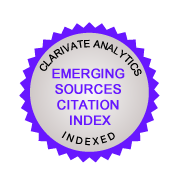General Chemistry content learning using videos in Engineering careers
DOI:
https://doi.org/10.24310/innoeduca.2019.v5i2.3566Keywords:
blended learning, itc, educational video, university educationAbstract
PALABRAS CLAVE: APRENDIZAJE MIXTO; TIC; VIDEO EDUCATIVO; EDUCACIÓN UNIVERSITARIA.
ABSTRACT:
Freshmen of Engineering degrees (Electrical, Electronics and Surveying) at the Faculty of Exact and Natural Sciences and Surveying (FaCENA) of the Universidad Nacional del Nordeste (UNNE) study General Chemistry, according to current curricula. This article presents the results of a comparative study that explores the effect of the implementation of educational videos in the understanding of fundamental contents of the subject such as chemical nomenclature, chemical equations and stoichiometry. These are the first topics developed in practical classes; they are the cornerstone of other contents of the program, and they are evaluated in the first test.
For the study, we have analysed the answers given in an evaluation by two cohorts, 2014 (traditional classroom format) and 2015 (with video support). Then, the Student’s t-test has been applied to determine if there is significant difference between the two.
In the three thematic blocks, the difference found between both groups is significant. The statistical calculation allows to assert that the use of videos as a resource is the variable that is causing the difference of having better results in the 2015 cohort.
The most significant difference between the two groups is in stoichiometry, and the less significant in chemical equations.
Downloads
Metrics
References
Caamaño A. (Coord.) (2011). Física y Química. Complementos de formación disciplinar. Vol. I. Barcelona, España: Graó.
Caamaño, A. (coord.) (2011). Didáctica de la Física y la Química. Vol. II. Barcelona, España: Graó.
Caamaño A. (Coord.) (2011). Física y Química. Investigación, innovación y buenas prácticas. Vol. III. Barcelona, España: Graó.
Cabero Almenara, J. (2007). El video en la enseñanza y formación. En Cabero, J. (coord.), Nuevas tecnologías aplicadas a la educación. Madrid: McGraw-Hill.
Cacheiro González, M.L. (2011). Recursos educativos TIC de información, colaboración y aprendizaje. Pixel-Bit. Revista de Medios y Educación, 39,69-81. Recuperado de:http://www.redalyc.org/articulo.oa?id=36818685007.
Daza Pérez, E., y cols. (2009). Experiencias de enseñanza de la Química con el apoyo de las TIC. Educación Química. De Aniversario: la educación y las TIC, pp.321- 330.
Izquierdo, M. (2011). Historia de la Química y enseñanza de la Química. En Caamaño A. (Coord.) (2011). Física y Química. Complementos de formación disciplinar. Vol. I, p 54.
Martínez, M.S.; De Longhi, A. (2011). Identificación de las dificultades en la interpretación de enunciados de problemas en química aplicada. E-book. Córdoba: Universidad Nacional de Córdoba. Disponible en https://rdu.unc.edu.ar/handle/11086/2150.
Mellado, V. (2011). Formación del profesorado de ciencias y buenas prácticas: el lugar de la innovación y la investigación didáctica. En Caamaño A. (Coord.) (2011), Física y Química. Investigación, innovación y buenas prácticas, Vol. III, p.21. Barcelona, España: Graó.
Mondeja González, D., y Zumalacárregui de Cárdenas, B. (2009). Química virtual en la enseñanza de las ingenierías de perfil no químico. Pedagogía Universitaria, 14(1), pp.9-17. Recuperado de http://cvi.mes.edu.cu/peduniv/index.php/pe duniv/article/view/480.
Morales Capilla, M.; Ortíz Colón, A.M.; Trujillo Torres, J.M. y Raso Sánchez, F. (2015). Percepción del alumnado universitario acerca del uso e integración de las TIC en el proceso educativo en la Facultad de Educación de Granada. Innoeduca. International Journal of Technology and Educational Innovation. 1 (2), pp.57-68.
Peterson, W. R.(2012). Fundamentos de Nomenclatura Química. Barcelona: Reverté.
Pintó, R.(2011). Las Tecnologías digitales en la enseñanza de la Física y de la Química. En Caamaño A. (coord. 2011). Didáctica de la Física y la Química, Vol. II, pp.172-179. Barcelona, España: Graó.
Sanabria, A. y Hernández, C. (2011). Percepción de los estudiantes y profesores sobre el uso de las TIC en los procesos de cambio e innovación en la Enseñanza Superior. Aloma, 29, pp.273-290. Disponible en: http://www.raco.cat/index.php/Aloma/article/view/248394/332518.
Downloads
Published
How to Cite
Issue
Section
License
All contents published by Innoeduca. International Journal of Technology and Educational Innovation are subject to Creative Commons Attribution-Nocomercial-NoDerivatives 4.0 International License, whose complete text can be consulted at https://creativecommons.org/licenses/by-nc-nd/4.0/legalcode. Thus, copying, distribution, public communication, derivative works and commercial use of content are permitted as of the aforementioned issue provided that the source and the author of the text are cited.
It is the responsibility of the authors to obtain the necessary permits for images that are subject to copyright.

This work is licensed under a Creative Commons Attribution-NonCommercial-NoDerivatives 4.0 International License.
10.1109/RITA.2022.3191299
10.19053/22160159.v14.n37.2023.15616
10.24310/ijtei.101.2024.17432








1.jpg)



242.png)








